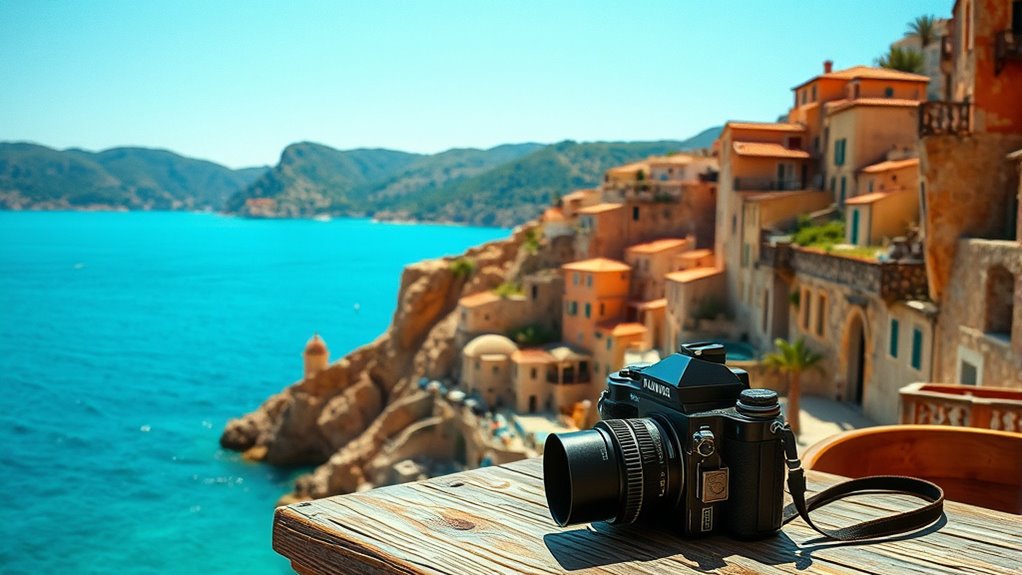Sardinia’s contribution to Italian cinema is rich and diverse, from its early days with films highlighting local customs and landscape to its influence on neorealist storytelling. The island’s rugged landscapes have served as iconic settings for Westerns and genre films, while filmmakers have used Sardinian symbols and dialects to explore regional identity. Modern cinema continues to challenge stereotypes and promote cultural preservation. To discover how Sardinia’s evolving film scene shapes Italy’s cinematic landscape, keep exploring.
Key Takeaways
- Sardinian cinema has historic roots dating back to the late 19th century, highlighting regional identity through early films and literary themes.
- Regional filmmakers focus on local social realities, rural life, and landscapes, contributing to Italy’s Neorealist movement.
- Contemporary Sardinian films challenge stereotypes, depicting urban life, youth, and global influences, enriching Italy’s diverse cinematic landscape.
- Sardinia’s natural landscapes and unique cultural symbols serve as versatile settings, attracting regional and international film productions.
- The Sardegna Film Commission and infrastructure investments support regional film development, fostering Sardinia’s growing role in Italian cinema.
Early Depictions and Cultural Foundations in Sardinian Film
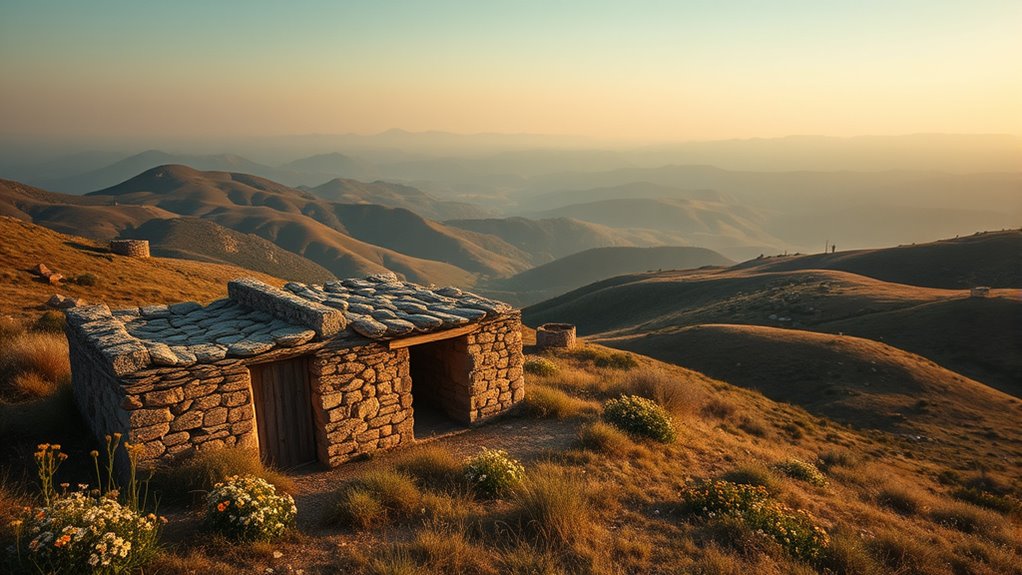
The roots of Sardinian cinema can be traced back to the late 19th and early 20th centuries, when filmmakers began capturing the island’s unique landscapes and cultural scenes. Your journey starts with Francesco Felicetti’s 1899 film, “Voyage du Roi Humbert Ier en Sardaigne,” documenting the royal visit. Early productions like “Cainà,” “The Grace,” and “Ashes” drew inspiration from Sardinian themes and literary figures such as Grazia Deledda. Despite limited activity before the 1920s, these films showcased local customs, rural life, and regional stories, laying cultural foundations for future cinematic work. Archival materials and multiple versions of early films preserve this heritage, emphasizing the importance of Sardinian identity in shaping Italy’s regional film landscape. These early works serve as a testament to Sardinia’s distinct cultural voice within the broader Italian film history.
The Role of Sardinian Cinema in Neorealist Movements
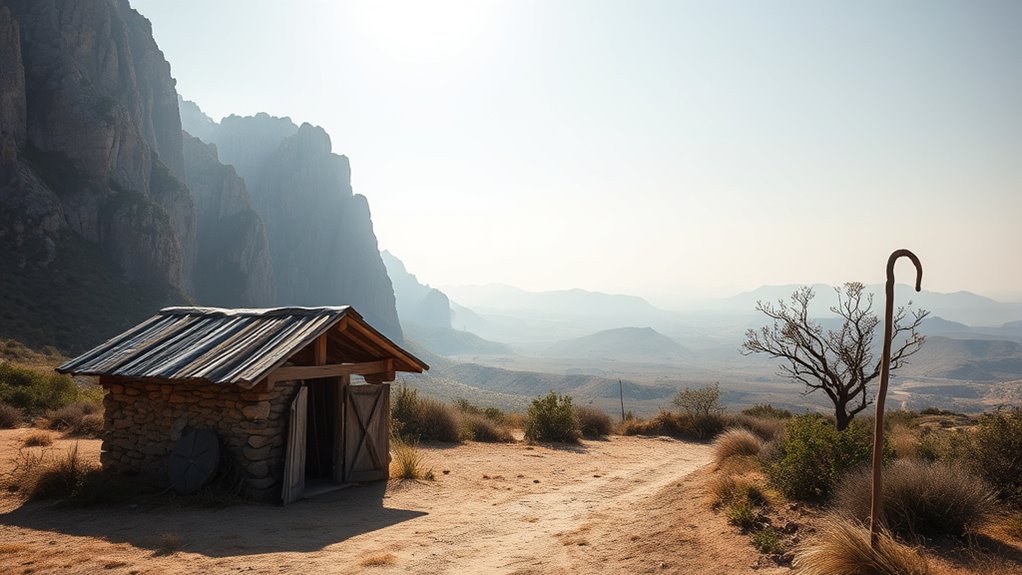
Sardinian filmmakers played a pivotal role in shaping Italian Neorealism by focusing on regional social realities and local struggles that reflected broader national issues. Their films highlighted Sardinia’s economic hardships, rural poverty, and class struggles, aligning with Neorealism’s themes of social injustice. Using nonprofessional actors and natural settings, they created authentic portrayals that rejected glamorized illusions. Documentaries by directors like Fiorenzo Serra offered raw glimpses into Sardinian life, emphasizing the island’s cultural memory and resistance to homogenization. These films also examined the effects of capitalism on rural communities and depicted themes of poverty, displacement, and survival. Sardinian cinema’s emphasis on on-location shooting and social critique reinforced Neorealism’s commitment to portraying Italy’s diverse, often marginalized, experiences. Sardinian filmmakers also contributed to establishing a regional cinematic voice that challenged dominant narratives and celebrated local traditions and identities. Moreover, their work helped to preserve and promote regional culture amidst Italy’s rapidly changing social landscape.
Sardinia as a Backdrop for Western and Genre Films
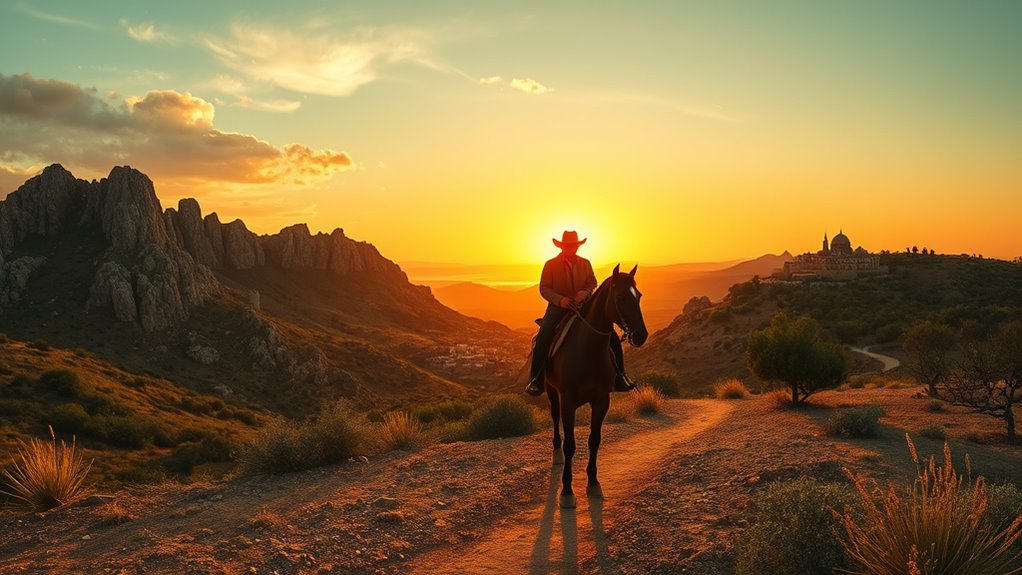
While Sardinia’s rugged social landscapes once inspired films focused on regional struggles, its stunning and varied scenery has also made it a popular backdrop for Western and genre movies. Locations like San Salvatore di Sinis and San Salvatore di Cabras, with their Western-style facades, transformed into Wild West towns in the 1960s, evoke the American frontier. The northern coast, including Cala Moresca Beach and Castelsardo, offers natural beauty ideal for film settings, while Marina di Arbus’s rugged coastline appeared in *The Black Stallion*. These landscapes mimic the American West, attracting low-budget Western productions despite limited film infrastructure. Sardinia’s natural scenery, combined with local participation, has helped it serve as a versatile setting for genre films, from Westerns to adventure stories. Furthermore, Sardinia’s diverse terrains—including deserts, mountains, and coastal plains—provide a rich variety of environments suitable for different film genres. Additionally, the island’s versatile landscapes continue to draw filmmakers seeking authentic settings.
Iconic Sardinian Filmmakers and Thematic Focuses
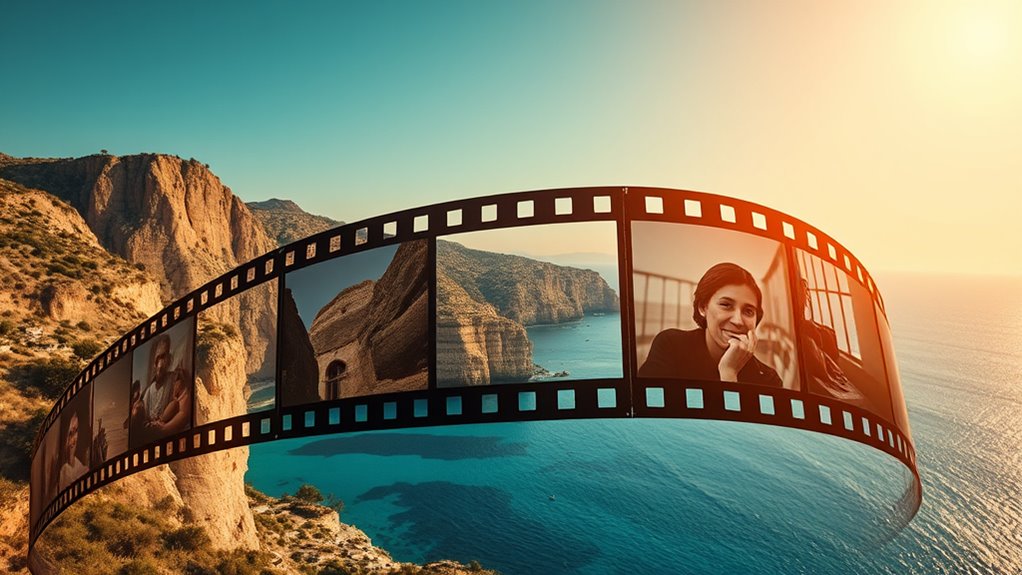
You’ll see how Sardinian filmmakers like the Taviani brothers and Gianfranco Cabiddu have shaped the island’s cinematic identity through themes of rural life and cultural heritage. Their works highlight Sardinia’s traditions, struggles, and landscape, creating a vivid sense of place. By exploring both historical and modern issues, these directors reveal the complexity of Sardinian society on screen. The island’s rich film history continues to influence contemporary cinema, ensuring Sardinia’s unique voice remains prominent in Italian film. Additionally, their focus on regional storytelling emphasizes the importance of cultural preservation within the cinematic narrative.
Notable Sardinian Directors
Italy’s cinematic landscape is enriched by a group of talented directors whose roots lie in Sardinia, each bringing unique perspectives and themes to the screen. Paolo Zucca stands out for his films like *L’arbitro* and *The Man Who Bought the Moon*, blending Sardinian identity with broader Italian narratives. Nanni Loy, born in Cagliari, revolutionized Italian cinema with works like *The Four Days of Naples* and pioneering social comedy, earning international recognition. Salvatore Mereu, from Dorgali, champions authentic Sardinian stories through intimate films like *Pretty Butterflies* and *Ballo a tre passi*. Giovanni Coda focuses on socially engaged cinema, highlighting LGBTQ+ and political themes, while Franco Solinas, a celebrated screenwriter, influenced Italy’s political and social narratives with his compelling scripts.
Cultural and Thematic Focus
Sardinian filmmakers have long used their craft to explore the island’s rich cultural identity and pressing social issues, shaping a distinctive cinematic voice. They focus on:
- Environmental themes, highlighting Sardinia’s landscapes and ecological concerns like climate change and sustainability, often through eco-conscious productions and initiatives. Italian cinema’s influence on global environmental narratives has inspired Sardinian filmmakers to incorporate ecological themes into their storytelling. Additionally, their attention to local ecological issues underscores a commitment to raising awareness through film.
- Rural and shepherd life, portraying traditional livelihoods with authenticity, featuring locals and exploring social realities like banditry and community resilience.
- Historical and social reflection, addressing topics such as resistance, identity, and Sardinia’s role in broader Mediterranean history, often challenging romanticized views.
- Cultural heritage, emphasizing language, folklore, and traditions to preserve and celebrate regional identity amid modern influences. These themes create a layered, meaningful cinematic narrative rooted in Sardinia’s unique character.
Regional Identity and Social Narratives in Sardinian Cinema
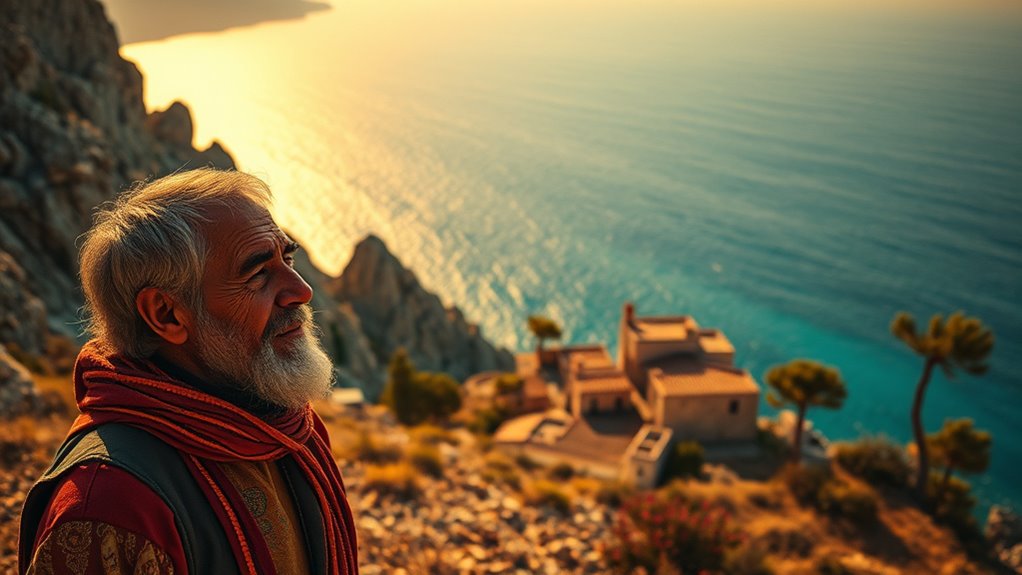
Regional identity in Sardinian cinema has evolved from depicting the island as an isolated and archaic place to highlighting its historical role as a crossroads of diverse cultures. You’ll notice films move away from focusing solely on Barbagia, instead portraying a dynamic, interconnected Sardinia. Historical figures like Eleonora d’Arborea symbolize pride and identity, while symbols like nuraghi, traditional costumes, and the Sardinian language reinforce local roots. Modern narratives challenge stereotypes, showing Sardinians negotiating between tradition and global influences. Instead of portraying Sardinia as exotic or timeless, recent films explore a more nuanced identity—one that balances regional specificity with openness to outside ideas. This shift reveals a vibrant, evolving cultural landscape, reflecting contemporary Sardinian life beyond old stereotypes. This development underscores the importance of regional storytelling in shaping a diverse and multi-layered Sardinian cultural image. Additionally, the use of local dialects in films enhances authenticity and deepens the connection to Sardinian heritage.
Sardinia’s Influence on Italy’s Regional Film Industries

Since its establishment in 2006, the Sardegna Film Commission has played a pivotal role in integrating Sardinia into Italy’s wider regional film industry. It boosts regional influence through:
- Providing logistical support, location scouting, and streamlined permits, making Sardinia attractive for productions.
- Offering financial incentives like the Sardegna Film Fund and Cagliari 2024 fund, ensuring economic benefits locally.
- Showcasing Sardinia’s landscapes—like Capo Caccia and Piscinas beaches—as versatile settings for diverse genres.
- Collaborating with local authorities and private sectors to connect Sardinian productions to national and international markets. This collaborative approach enhances Sardinia’s visibility within Italy’s film ecosystem.
These efforts strengthen Sardinia’s position as a essential, distinctive hub within Italy’s regional film ecosystem, fostering culturally rich storytelling and sustainable growth.
Preservation and Academic Documentation of Sardinian Film Heritage
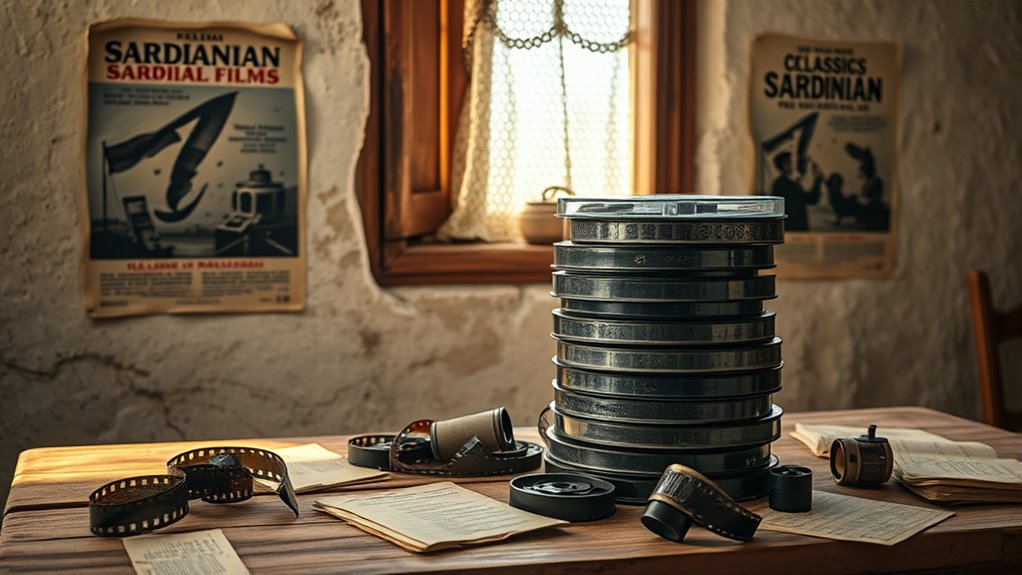
You can explore Sardinia’s film history through key scholarly works that analyze regional cinema and cultural identity. Preservation efforts by institutions like the Cagliari State Archives guarantee these materials remain accessible for research and study. By understanding these processes, you’ll see how academic documentation safeguards Sardinian cinema’s legacy for future generations. Proper storage of film-related materials ensures their long-term stability and accessibility for ongoing research. Implementing self watering plant pots in preservation facilities can help maintain optimal environmental conditions for delicate film materials, ensuring their longevity.
Key Scholarly Works
Despite its rich cinematic history, Sardinian film heritage remains underrepresented in scholarly literature, especially in English-language research. You should know that:
- Sardinian documentary cinema is largely underexplored, with little academic analysis, even in Italian scholarship. This neglect continues despite the island’s unique visual and cultural landscape. Furthermore, the lack of comprehensive film archives hampers systematic research efforts.
- Silvio Carta’s doctoral thesis is a rare scholarly effort, addressing this gap and offering detailed insights.
- Most studies focus on external representations, often perpetuating stereotypes, rather than local perspectives.
- Recent scholarship emphasizes deconstructing myths and contextualizing films within Sardinia’s cultural and historical frameworks.
This limited attention stems from the films’ restricted circulation and historical marginalization. Recognizing these gaps is essential for advancing the academic documentation and preservation of Sardinian cinematic heritage.
Archival Preservation Efforts
Preserving Sardinian cinema requires dedicated efforts from both national institutions and regional archives. The Cineteca Nazionale, Italy’s main film archive, plays a central role by conserving and restoring Sardinian works within its collection of around 60,000 titles. It ensures regional films are safeguarded alongside national masterpieces through rigorous restoration protocols and promotes access through annual screenings domestically and internationally. Additionally, the SAFE Project advances digital preservation and sustainable archival infrastructure across Italy, including Sardinian materials, while developing tools like a digital Atlas to visualize collection data. Regional resources like the Cagliari State Archives support film preservation indirectly by maintaining historical documents that contextualize Sardinian cinema. Together, these efforts strengthen the academic documentation and public accessibility of Sardinian film heritage. The Cineteca Nazionale is recognized as Italy’s most important cinematographic archive, emphasizing its broad scope and national significance.
The Evolution of Sardinian Representation in Contemporary Cinema

In recent years, Sardinian cinema has begun to challenge longstanding stereotypes by presenting more complex and diverse portrayals of the island. You’ll notice a shift toward modern narratives that reflect urban life, youth culture, and global influences. Key developments include:
- Filmmakers like Enrico Pau showcasing Sardinia’s contemporary identity beyond rural stereotypes.
- Films exploring internal diversity, such as different social classes and generational perspectives.
- Efforts to integrate Sardinian characters into broader Italian and Mediterranean contexts, highlighting the father-daughter bond and familial relationships that are central to Sardinian culture.
- A gradual move away from exoticized, archaic images toward authentic representations of modern Sardinian society.
While some films still rely on traditional tropes, this evolution signals a more nuanced, realistic portrayal of Sardinia’s evolving cultural landscape.
Future Perspectives and Opportunities for Sardinian Film Production
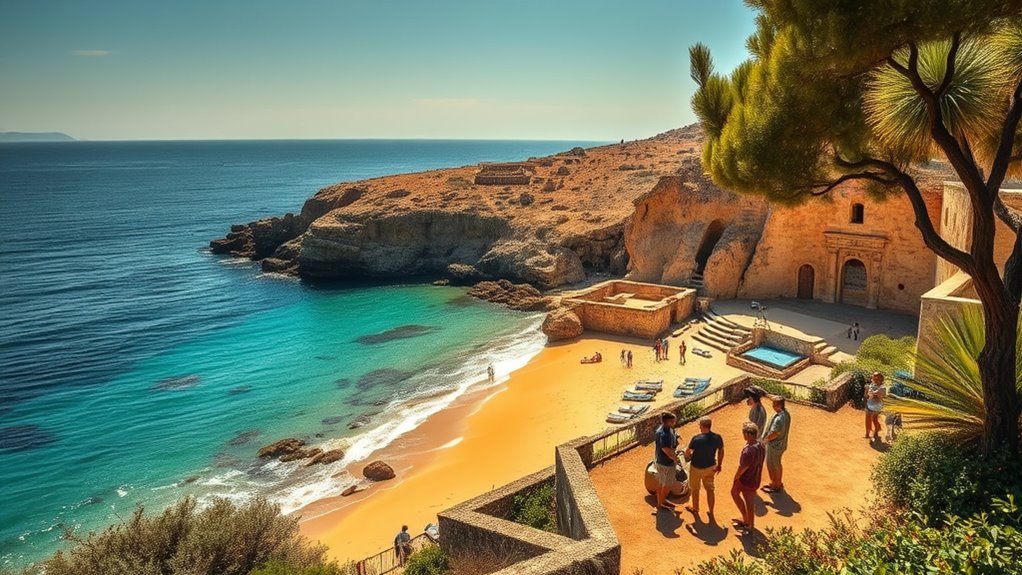
Future prospects for Sardinian film production look promising, driven by increased investment, technological advancements, and growing international interest. The Sardinia Region and local municipalities actively support film projects through funding and infrastructure, making the island more attractive for creators. Partnerships with global streaming giants like Netflix, Amazon, and Disney are opening new opportunities for international collaborations. Sardinia’s eco-friendly practices and investment in green technologies align with industry values, boosting sustainable production. The island’s diverse landscapes and rich cultural heritage offer unique settings, drawing major productions and elevating its profile. Festivals like Filming Italy Sardegna foster cultural exchange, community engagement, and tourism. Recent investments in local film infrastructure have further enhanced Sardinia’s appeal as a filming location, positioning Sardinia as a vibrant, forward-looking hub for film production and innovation.
Frequently Asked Questions
How Has Sardinia’S Landscape Influenced Italian Film Genres Beyond Westerns?
You see how Sardinia’s landscape influences Italian film genres beyond Westerns by providing diverse and visually striking settings. Its ancient ruins, lush greenery, and unique villages inspire historical dramas, environmental films, and thrillers. You’ll notice filmmakers use the island’s natural features to deepen storytelling, explore cultural themes, and create atmospheric backdrops. Sardinia’s landscapes help convey complex social messages and evoke a sense of otherness, enriching Italy’s cinematic tapestry.
What Are the Main Cultural Stereotypes Associated With Sardinian Characters in Italian Cinema?
You see Sardinian characters often portrayed as rugged, stubborn, and deeply tied to traditional roles. Men are depicted as peasants, bandits, or shepherds, embodying honor and violence, while women are shown as moral, nurturing figures. These stereotypes emphasize rural toughness, social stagnation, and separatist pride, often exaggerating traits like stubbornness, primitiveness, and isolation. Italian cinema tends to reinforce these clichés, simplifying Sardinian culture into rustic, sometimes criminal, regional archetypes.
How Do Sardinian Filmmakers Address Regional Identity in Their Contemporary Works?
You see Sardinian filmmakers actively explore their regional identity by blending traditional myths with modern realities, emphasizing the island’s unique culture. They use innovative storytelling, mixing documentary and fiction, to reflect social issues like industrialization and environmental challenges. Through audiovisual experiments and media hybridity, they challenge stereotypes and portray Sardinia’s complex history, territory, and memory. Their works foster a deeper understanding of Sardinian heritage, connecting local stories to broader cultural conversations.
In What Ways Has Sardinian Cinema Impacted Italian National Film Policies?
You see, Sardinian cinema has considerably shaped Italian national film policies by highlighting regional stories and cultural themes. Your work promotes ecological sustainability, encouraging policies supporting green filmmaking. As Sardinian films gain recognition, they attract government funding and grants, fostering diverse narratives. Your focus on local social issues and rural life enriches Italy’s cinematic landscape, prompting policies that value regional representation, cultural preservation, and social dialogue across the nation.
What Challenges Does Sardinian Cinema Face in Gaining Broader Recognition?
You’re wondering how Sardinian cinema struggles for recognition, and the answer might surprise you. Its geographic isolation limits access to wider audiences and essential industry networks, while cultural differences make mainstream appeal difficult. Limited distribution channels and funding further hinder visibility. Add in the challenge of balancing authenticity with broader cinematic standards, and you see why Sardinian films often stay confined to regional circles, struggling to break into national and international consciousness.
Conclusion
You see how Sardinia shapes Italian cinema through its history, its stories, and its landscapes. You recognize its influence in shaping regional identities, inspiring filmmakers, and documenting social truths. You understand that Sardinia’s contribution goes beyond the screen—it’s about preserving culture, advancing creativity, and inspiring future generations. You realize that Sardinian cinema isn’t just a part of Italy’s film history; it’s a essential, ongoing story waiting to be explored and celebrated.
